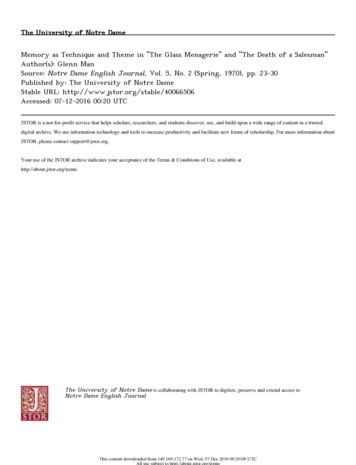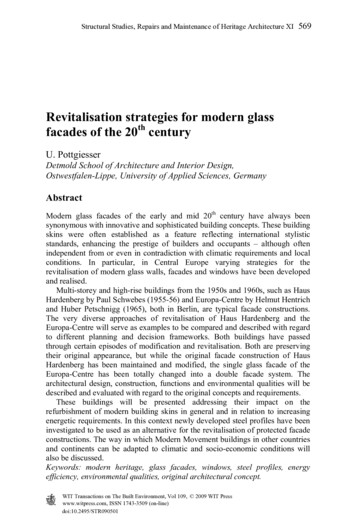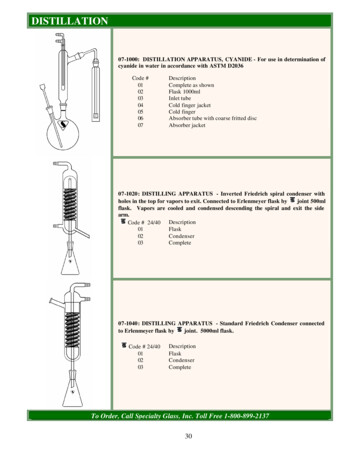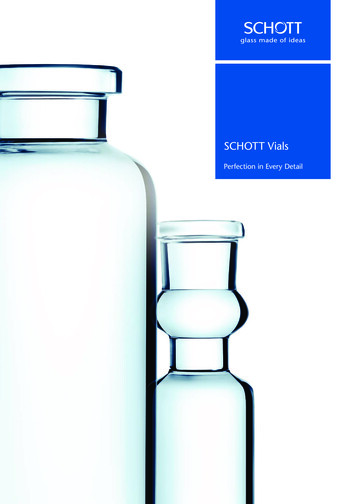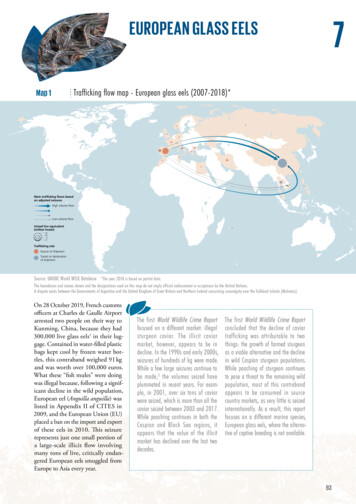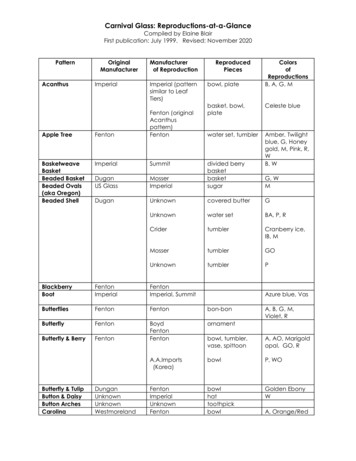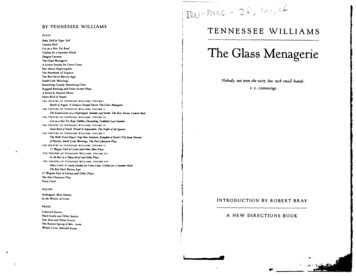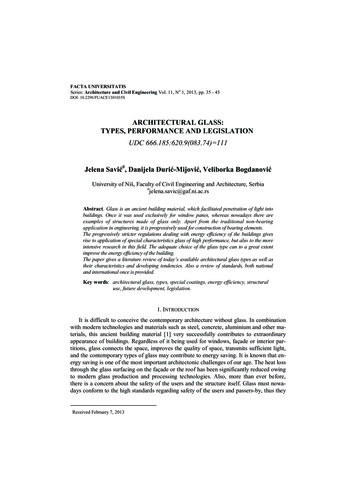
Transcription
FACTA UNIVERSITATISSeries: Architecture and Civil Engineering Vol. 11, No 1, 2013, pp. 35 - 45DOI: 10.2298/FUACE1301035SARCHITECTURAL GLASS:TYPES, PERFORMANCE AND LEGISLATION UDC 666.185:620.9(083.74) 111Jelena Savić#, Danijela Đurić-Mijović, Veliborka BogdanovićUniversity of Niš, Faculty of Civil Engineering and Architecture, Serbia#jelena.savic@gaf.ni.ac.rsAbstract. Glass is an ancient building material, which facilitated penetration of light intobuildings. Once it was used exclusively for window panes, whereas nowadays there areexamples of structures made of glass only. Apart from the traditional non-bearingapplication in engineering, it is progressively used for construction of bearing elements.The progressively stricter regulations dealing with energy efficiency of the buildings givesrise to application of special characteristics glass of high performance, but also to the moreintensive research in this field. The adequate choice of the glass type can to a great extentimprove the energy efficiency of the building.The paper gives a literature review of today’s available architectural glass types as well astheir characteristics and developing tendencies. Also a review of standards, both nationaland international once is provided.Key words: architectural glass, types, special coatings, energy efficiency, structuraluse, future development, legislation.1. INTRODUCTIONIt is difficult to conceive the contemporary architecture without glass. In combinationwith modern technologies and materials such as steel, concrete, aluminium and other materials, this ancient building material [1] very successfully contributes to extraordinaryappearance of buildings. Regardless of it being used for windows, façade or interior partitions, glass connects the space, improves the quality of space, transmits sufficient light,and the contemporary types of glass may contribute to energy saving. It is known that energy saving is one of the most important architectonic challenges of our age. The heat lossthrough the glass surfacing on the façade or the roof has been significantly reduced owingto modern glass production and processing technologies. Also, more than ever before,there is a concern about the safety of the users and the structure itself. Glass must nowadays conform to the high standards regarding safety of the users and passers-by, thus they Received February 7, 2013
36J. SAVIĆ, D. ĐURIĆ-MIJOVIĆ, V. BOGDANOVIĆare made resistant to shocks and abrupt temperature changes, and in chase they are damaged or shattered, they would not break in. The manufacturers tried in this way to keepthe risk of injury to a minimum.Glass nowadays is an integral part of many facades and roofs. This material can beeasily shaped and installed, crating in this way the structures which are gripping anddominating. However, apart from esthetic criteria, a contemporary structure must meet anumber of criteria which are necessary for creation of adequate comfort within a structure. In order to improve the comfort of the occupants by an increase in the quality of interior space and optimization of natural resources, it is necessary to conceive of a buildingwith an "interactive" envelope.When selecting the type and use of glass in a project, one looks for an optimal balancebetween aesthetics and function. The wide variety of architectural glass commerciallyavailable coupled with the versatility and creativity one can explore with the materialmakes the design process exciting and challenging. The transparency and translucency ofglass has historically given an aesthetic quality to architecture like no other material. Itgives a building the ability to change, to move, and to create certain environments. Theway in which light transmits through a piece of glass in building can be a powerful designtool for an architect. Glass can reflect, bend, transmit, and absorb light, all with great accuracy. Most architectural glass is partially transparent with little reflectance and absorbency. There are hundreds of glass compositions as well as different coatings, colors,thick-nesses, and laminates, all of which affect the way light passes through the material.Fig. 1. Contemporary glass may adapt to variety of architectural forms2. TYPES OF ARCHITECTURAL GLASSThe development of the float glass process in the 1950s allowed the economical massproduction of high quality flat glass and virtually all architectural glass is now producedby this process. The focus of intensive research and development aimed at maximizing itstree most attractive traits: the ability to transmit light, block heat and safety issues. Theseefforts have engendered a number of significant advances, from the introduction of uncoated spectrally selective glass to the rise of multi-cavity insulating glass units. Safety issues have a high importance on glass applications, because of potential life safety hazardto pedestrians and building occupants. Today, the vast majority of new windows, curtainwalls and skylights for commercial building construction have insulating glazing for energy efficiency and comfort. Nevertheless, high-quality glass products also give the op-
Architectural Glass: Types, Performance and Legislation37portunity to design load-bearing structural elements or systems constructed primarily ofglass, such as staircases, floors, walls and bridges.Architectural glass comes in three different strength categories [2]: annealed glass,heat-strengthened glass and fully-tempered glass. Annealed glass is the most commonlyused architectural glass. It has good surface flatness because it is not heat-treated andtherefore not subject to distortion typically produced during glass tempering. On thedownside, annealed glass breaks into sharp, dangerous shards. Heat-strengthened andfully-tempered glass are heat-treated glass products, heated and quenched in such a wayto create residual surface compression in the glass. The surface compression gives theglass generally higher resistance to breakage than annealed glass. Heat-strengthenedglass has at least twice the strength and resistance to breakage from wind loads or thermalstresses comparing to annealed glass. The necessary heat treatment generally results insome distortion compared to annealed glass. Like annealed glass, heat-strengthened glasscan break into large shards. Fully-tempered glass (toughened glass) provides at leastfour times the strength of annealed glass, which gives it superior resistance to glass breakage. It is float or plate glass that has been heated and rapidly cooled, increasing its inherent strength and ductility. Similar to heat-strengthened glass, the heat-treatment generallyresults in some distortion. If it breaks, fully-tempered glass breaks into many small fragments, which makes it suitable as safety glazing under certain conditions. It is used forwindows that are exposed to high wind pressure or extreme heat or cold (Fig. 2a). Properties of annealed and fully-tempered glass [4] are comparatively provided in Table 1.Table 1. Properties of GlassStrengthYoung’s modulusDensityThermal coefficient of expansionPoisson’s ratioAnnealed glassToughened glass(fully tempered)59–150 N/mm270 kN/mm22.4 kg/m38.8*10 6 K 10.227–28 N/mm270 kN/mm22.4 kg/m38.8*10 6 K 10.22The following are specialized glass types that are made with different qualities to enhance their performance [3]: Laminated glass (Fig. 2b) involves sandwiching a transparent sheet of polymer,such as polyvinyl butryal, between two or more layers of flat glass using an adhesive. Because it can prevent the fall-out of dangerous glass shards following fracture, it is often used as safety glazing and as overhead glazing in skylights. It is adurable and versatile glass with plastic interlayer which provides protection fromultraviolet rays and attenuates vibration, and gives laminated glass good acousticalcharacteristics. Can be used in a variety of environments. Insulating glass consists of two or more lites of glass separated by a hermeticallysealed space for thermal insulation and condensation control. The airspace betweenthe glass lites can be filled during the manufacturing process with either dry air or alow-conductivity gas, such as sulfur hexafluoride or argon. The thermal performanceof double-glazed or triple-glazed windows can be further improved by the addition of
38J. SAVIĆ, D. ĐURIĆ-MIJOVIĆ, V. BOGDANOVIĆa low-emissivity coating on one or all of the layers of glass. The air space also reducesheat gain and loss, as well as sound transmission, which gives the insulating glasssuperior thermal performance and acoustical characteristics compared to single glazing.Most commercial windows, curtain walls, and skylights contain insulating glass.a)b)Fig. 2. Appearance: a) tempered glass, b) laminated glass Coated glass is covered with reflective or low-emissivity (low-E) coatings. In additionto providing aesthetic appeal, the coatings improve the thermal performance of theglass by reflecting visible light and infrared radiation. Tinted glass contains minerals that color the glass uniformly through its thicknessand promote absorption of visible light and infrared radiation. Wire glass involves steel wires rolled into sheets of glass. A wire mesh is insertedduring the manufacturing of plate glass, allowing the glass to adhere together whencracked. It can qualify as safety glass for some applications.3. SPECIAL GLASS COATINGSGlass provides high compression strength and perfect transparency – but also thepossibility to alter its transparency through the integration of materials which have aswitchable light transmissivity. Today’s coating technologies, as well as the possibility ofreinforcing glass with different stiffening materials; open a nearly endless range of newways of using glass. Glass and façade manufacturers now offer a wider range ofaffordable glazing system solutions which will provide better thermal and solar controlwithout sacrificing daylight, and perhaps control surface temperature at the inside face ofthe glass to maintain human comfort.Self-cleaning or easy-to-clean glass [5] uses titanium dioxide coatings as a catalystto break up organic deposits. It requires direct sunlight to sustain the chemical reactionand rainwater to wash off the residue. Anorganic deposits are not affected by the coatings.Photochromic coatings [6,7] incorporate organic photochromic dyes to produce selfshading glass. Originally developed for sunglasses, these coatings are self-adjusting toambient light and reduce visible light transmission through the glass. They provide a moreevenly (in terms of time) distributed illumination of interior space regardless of exteriorvariations and they are typically used to provide shading.Glass with electrochromic coatings [6] utilizes a small electrical voltage, adjustedwith dimmable ballasts, to adjust the shading coefficient and visible light transmission.
Architectural Glass: Types, Performance and Legislation39Upon switching off the power, they retain the same degree of dimming. In this way it is possibleto control the shading of the façade, and thus illumination and temperature of the interior (Fig.3). Like photochromic coatings, they are intended to attain lighting energy savings.Fig. 3. Electrochromic coatingsThermochromic laminated glazing (TLG) enables to regulate daylight, automaticallyadapting dynamically to the continuously changing climatic conditions, aids in reducingthe energy needs of a building and providing thermal comfort. Neither electrical powernor driving unit are required. The polymeric interlayer of TLG is doped with complexesof transition metals, which change their coordination and transmission or color of the filmunder influence of light and heat fluxes (Fig. 4).They are favorable for regulation of interior temperature [6] in comparison to thephotochromic glass, because the external temperature and degree of illumination need notbe directly mutually dependent, especially in winter.Fig. 4. Sunlight responsive thermochromic glass: (a) windows are tinted by direct sunlight;(b) windows are clearer as they are only exposed to indirect sunlight4. POTENTIAL FOR FUTURE DEVELOPMENTTo attain, new social, economic and technological ideals architects and engineers oftoday must improve the quality of buildings and establish new principles of conceptualdesign of buildings. The quality of interior space and the impact of a building on its sur-
40J. SAVIĆ, D. ĐURIĆ-MIJOVIĆ, V. BOGDANOVIĆroundings depend strongly on the physical interface that separates the outer environmentfrom the inner building space. The conception and realization of this envelope are therefore of prime importance.Fig. 5. Glass combined with contemporary technical systems for ventilation,shading and collecting of the Sun energyConsidering market issues it is obvious that growth of demand for glass is not only aconsequence of economic growth but also regulations concerning safety, reduction ofnoise and growing demands in terms of energy efficiency of buildings. However, the lackof standards regulating use of glass in engineering can, in perspective, reduce the growthof glass use in construction.The main growth drivers that will influence the flat glass consumption in buildingsand civil engineering respond to several contemporary demands, presented in Table 2.Table 2. Growth drivers for future flat glass consumption [8]DemandGrowth DriversEnergy saving(heating)Energy saving(cooling)SafetySecurityFire protectionEnergy saving legislation and building regulations, reduction of energy loss frombuildings and energy labeling of windows.Energy saving legislation, reduction of air-conditioning load in buildings.Preventing non air-conditioned buildings from overheatingIncreasing legislative requirement for safety glassRequirement for transparency combined with security/safety featuresCompliance with fire regulations combined with requirements for good lighttransmissionIncreasing noise leve
It is difficult to conceive the contemporary architecture without glass. In combination with modern technologies and materials such as steel, concrete, aluminium and other ma-terials, this ancient building material [1] very successfully contributes to extraordinary appearance of buildings. Regardless of it being used for windows, façade or interior par-titions, glass connects the space .

